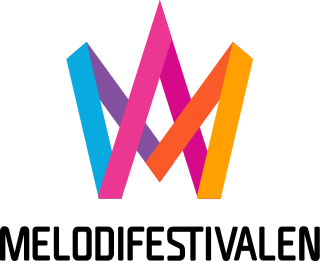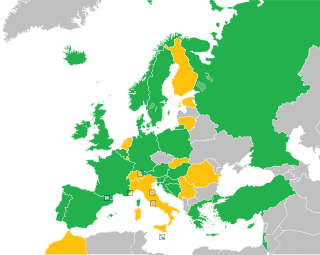
Sweden has participated at the Junior Eurovision Song Contest 11 times since its inception in 2003. Two broadcasters have been responsible for Sweden's entries at Junior Eurovision - from 2003 to 2005 Sveriges Television (SVT) was responsible, before withdrawing with other Nordic broadcasters. From 2006 to 2009, commercial broadcaster TV4 was responsible for Sweden's entry at the Junior Eurovision.
Melodifestivalen 1999 was the selection for the 39th song to represent Sweden at the Eurovision Song Contest. It was the 38th time that this system of picking a song had been used. 1,315 songs were submitted to SVT for the competition. The final was broadcast on SVT2 and Sveriges Radio's P4 network. Charlotte Nilsson went on to win that year's Eurovision Song Contest in Jerusalem, Sweden's fourth Eurovision win. A total of 630,339 votes were cast.

Melodifestivalen 2000 was the selection for the 40th song to represent Sweden at the Eurovision Song Contest. It was the 39th time that this system of picking a song had been used; 1,394 songs were submitted to SVT for the competition. The final was broadcast on SVT2 and Sveriges Radio's P4 network. Roger Pontare won the MF again with the rock-inspired ballad "När vindarna viskar mitt namn", donning a folk-inspired costume and featuring Native American dancers during his performance. The winning song was performed later in English at the Eurovision Song Contest as "The Spirits Are Calling My Name", placing seventh among 24 entrants.
Melodifestivalen 2001 was the selection for the 41st song to represent Sweden at the Eurovision Song Contest. It was the 42nd time that this system of picking a song had been used. 1,567 songs were submitted to SVT for the competition. The final was broadcast on SVT1 and Sveriges Radio's P4 network. The winners were Friends who later that year ended up in 5th place in the Eurovision Song Contest 2001 in Copenhagen with the English-language version of the song "Listen To Your Heartbeat". The show was watched by 3,840,000, with a total of 357,408 votes cast.
Melodifestivalen 1991 was the selection for the 31st song to represent Sweden at the Eurovision Song Contest. It was the 30th time that this system of picking a song had been used. 1,323 songs were submitted to SVT for the competition. The final was broadcast on TV2 and Sveriges Radio's P3 network. Carola Häggkvist went on to win that year's Eurovision Song Contest in Rome, Sweden's third Eurovision win. The show was watched by 5,880,000 people.
Melodifestivalen 1984 was the selection for the 24th song to represent Sweden at the Eurovision Song Contest. It was the 23rd time that this system of picking a song had been used. 90 songs were submitted to SVT for the competition. The final was broadcast on TV1 but was not broadcast on radio. Herreys went on to win that year's Eurovision Song Contest in Luxembourg; Sweden's second Eurovision win.
Melodifestivalen 1996 was the selection for the 36th song to represent Sweden at the Eurovision Song Contest. It was the 35th time that this system of picking a song had been used. 1,323 songs were submitted to SVT for the competition. The final was broadcast on SVT1 and Sveriges Radio's P3 and P4 networks. The show was watched by 3,775,000 people.
Melodifestivalen 1975 was the selection for the 16th song to represent Sweden at the Eurovision Song Contest. It was the 15th time that this system of picking a song had been used. 10 songwriters were selected by SVT for the competition. The final was broadcast on TV1 but was not broadcast on radio.
Melodifestivalen 1998 was the selection for the 38th song to represent Sweden at the Eurovision Song Contest. It was the 37th time that this system of picking a song had been used. 1,141 songs were submitted to SVT for the competition. The final was broadcast on SVT2 and Sveriges Radio's P4 network. The show was watched by 2,881,000 people.
Melodifestivalen 1997 was the selection for the 37th song to represent Sweden at the Eurovision Song Contest. It was the 36th time that this system of picking a song had been used. 1,229 songs were submitted to SVT for the competition. The final was broadcast on SVT2 and Sveriges Radio's P3 network. The winner was the boyband Blond who later that year represented Sweden in Eurovision Song Contest 1997. The show was watched by 2,965,000 people.
Melodifestivalen 1994 was the selection for the 34th song to represent Sweden at the Eurovision Song Contest. It was the 33rd time that this system of picking a song had been used. 1,560 songs were submitted to SVT for the competition. The final was broadcast on TV1 and Sveriges Radio's P3 and P4 networks. The show was watched by 3,780,000 people.
Melodifestivalen 1992 was the selection for the 32nd song to represent Sweden at the Eurovision Song Contest. It was the 31st time that this system of picking a song had been used. 1,544 songs were submitted to SVT for the competition. The final was broadcast on Kanal 1 and Sveriges Radio's P3 network. Christer Björkman's result at Eurovision was Sweden's worst since 1977, until 2003 the worst result of a Eurovision host country. The show was watched by 5,376,000 people.
Melodifestivalen 1990 was the contest for selection of the 30th song to represent Sweden at the Eurovision Song Contest. It was the 29th time that this method of picking a song had been used. 1,223 songs were submitted to SVT for the competition. The final was broadcast on TV2 but not on radio. The show was watched by 5,964,000 people, the biggest recorded audience for the competition.
Melodifestivalen 1988 was the selection for the 28th song to represent Sweden at the Eurovision Song Contest. It was the 27th time that this system of picking a song had been used. 1,100 songs were submitted to SVT for the competition. The final was broadcast on TV2 and was not broadcast on radio. The show was watched by 4,464,000 people.
Melodifestivalen 1987 was the selection for the 27th song to represent Sweden at the Eurovision Song Contest. It was the 26th time that this system of picking a song had been used. 1502 songs were submitted to SVT for the competition. The final was broadcast on TV1 and was not broadcast on radio. The winning song's title was changed to "Boogaloo" for the Eurovision Song Contest as it contained chewing gum brand Bugg as well drinks company Coca-Cola in the title.
Melodifestivalen 1986 was the selection for the 26th song to represent Sweden at the Eurovision Song Contest. It was the 25th time that this system of picking a song had been used. 90 songs were submitted to SVT for the competition. The final was broadcast on TV1 and was not broadcast on radio. No orchestra was used, and instead the ten songs were broadcast as music videos. The five songs that qualified for the second round were performed live to backing track.
Melodifestivalen 1980 was the selection for the 20th song to represent Sweden at the Eurovision Song Contest. It was the 19th time that this system of picking a song had been used. 120 songs were submitted to SVT for the competition. The final was broadcast on TV1 but was not broadcast on radio.
Melodifestivalen 1979 was the selection for the 19th song to represent Sweden at the Eurovision Song Contest. It was the 18th time that this system of picking a song had been used. 452 songs were submitted to SVT for the competition. The final was broadcast on TV1 but was not broadcast on radio.
Melodifestivalen 1977 was the selection for the 17th song to represent Sweden at the Eurovision Song Contest. Sweden did not participate in the Eurovision Song Contest 1976 due to demonstrations against commercial music. It was the 16th time that this system of picking a song had been used. 965 songs were submitted to SVT for the competition. The final was broadcast on TV1 but was not broadcast on radio.
Sweden participated in the Eurovision Song Contest 2014 in Copenhagen, Denmark. The Swedish entry was selected through Melodifestivalen 2014, a national final format that consisted of four semi-finals, a second chance round and a final, organised by Swedish broadcaster Sveriges Television (SVT). Sanna Nielsen represented Sweden with the song "Undo", which qualified from the first semi-final and placed 3rd in the final, scoring 218 points.




